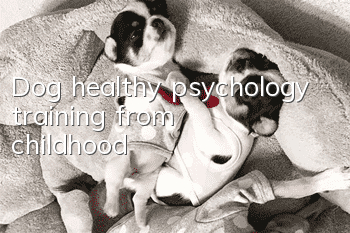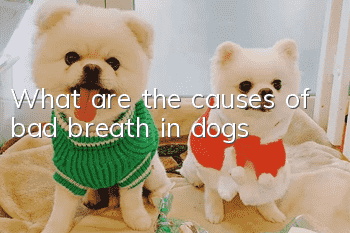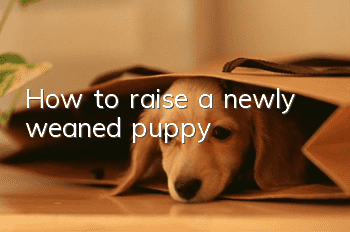Dog healthy psychology training from childhood

Logically speaking, a dog should be an optimistic person who has no worries.
But in fact this is not the case, just like the song goes, "A young boy rarely has worries... When he grows up, his worries increase." If you worry too much, it will naturally affect your mental health. As an owner, you definitely don’t want a “Lin Daiyu” dog that looks sad all day long, right?
A mentally healthy dog should be sunny, optimistic, happy... There is no need to say similar adjectives. A mentally unhealthy dog is mainly suspicious, timid, neurotic, manic, and in more severe cases, has a desire to attack.
Cultivate a healthy mentality from an early age
When a dog is young, it is the most important period for the development of psychological functions. During this period, creating a "moral, intellectual, physical, artistic, and labor" environment for the dog that is conducive to its physical and mental development is very helpful in shaping the dog. Healthy psychology.
There is a very close relationship between the psychological development of dogs and their environment when they are young. When the dog meets its basic survival needs, the dog's psychology will be easily affected by various information from the outside world.
To cultivate a healthy psychology in young dogs, owners must first meet the dog’s safety needs, which is the basis of a healthy psychology. Young dogs only understand "benefits" and "harms" from the outside world. "Seeking advantages and avoiding disadvantages" is one of the most prominent characteristics of dogs. The sensory organs of dogs aged 2 to 6 weeks have gradually matured, and the "imprinting" learning method will play a great role at this stage. In layman's terms, it means that during this period, dogs can easily form a stable memory that is not easy to change in response to noxious stimuli from the outside world. Is it a bit like the "childhood shadow" that Mr. Freud often talked about?
During this period, the owner must take on the responsibility of a bodyguard and provide a safe environment for the dog so that the dog will not be inadvertently exposed to sudden stimulation. In this way, dogs "born in the new society and growing up under the red flag" will be confident in the revolutionary path of future growth.
Sticks may not produce “filial dogs”
No matter what breed they are, dogs are always naughty sometimes. Many owners believe in the theory of "sticks produce good dogs" when training their dogs. For this, moderate corporal punishment is necessary. But if you go too far, it will be just the opposite.
Corporal punishment of dogs must be coordinated with the right time, place, people and many other factors, otherwise it will easily leave a negative psychological shadow on the dog. For example, before corporal punishment, the dog must be able to catch the dog's mistakes (this is particularly important). When corporal punishment is carried out, other members of the family should not immediately protect the dog. The scale of corporal punishment should not be excessive. After appropriate corporal punishment, Don't "restore old friendship" with your dog immediately... With so many requests, you don't know whether you will punish the dog or the owner in the end.
Among so many conditions, one thing that needs to be mastered in particular is not to overdo it, nor to physically punish the dog multiple times in a short period of time. Otherwise, the dog may become frightened and tremble as soon as it sees its owner raising his hand or picking up a stick.Fearful, and even worse, some dogs will even grin in "self-defense."
Don’t drive the dog out
Sometimes the owner’s inadvertent actions may cause psychological harm to the dog, causing the dog to have a psychological shadow.
Some friends will leave their dogs to other places when they go out. This is a helpless move. As everyone knows, if not handled properly, the dog will be "very injured" because of this. Because the dog will think that if the owner puts it somewhere else for no reason, it is probably because the owner "doesn't want it" anymore.
If you have to put your dog in foster care, you may do a few things to minimize the damage to your dog. First of all, before fostering, the owner should take the dog to familiarize himself with the environment, so that the dog can leave an impression: Ah, this is not a strange and dangerous place! Secondly, it is best to find a "dog companion" for the dog in the foster care place, which will make the dog feel less lonely. Third, you must tell the foster carer about the dog’s living habits, and leave some items with the owner’s scent and utensils that the dog is accustomed to when fostering, so that the dog will feel safer.
For the sake of our "sunshine" dogs, owners must be careful.
- Why don’t dogs like having their paws touched?
- Why is the dog vomiting white foam?
- How to train Shiba Inu puppies? Daily training methods for Shiba Inu puppies!
- How to tell when dogs are constipated? Some common factors that cause dog constipation!
- What to do if your dog is hit by a car
- How do I discipline Alaska’s dog who loves to bite?
- St. Bernard dog gastroenteritis symptoms and treatments
- How to choose Samoyed? Samoyed buying tips!
- When your dog has these abnormal conditions, don’t you pay attention?
- What should novices pay attention to when buying a pet dog? These tips can help you!



